- The paper presents a new method for acquiring full Mueller-matrix hpBRDFs, enabling dense hyperspectral and polarimetric sampling of real-world materials.
- It details an integrated imaging system using broadband illumination, hyperspectral cameras, and inpainting techniques, validated with 94.5% physical admissibility.
- The study introduces compact neural and PCA models that reduce data size by up to five orders of magnitude and facilitate high-fidelity rendering.
Hyperspectral Polarimetric BRDFs of Real-world Materials: Dataset, Acquisition, and Analysis
Introduction
The paper presents a comprehensive methodology and dataset for measuring and modeling hyperspectral polarimetric bidirectional reflectance distribution functions (hpBRDFs) of real-world materials. Unlike prior BRDF datasets limited to intensity-only or sparse spectral/polarimetric sampling, this work provides full Mueller-matrix BRDFs across 68 spectral bands (414–950 nm), enabling detailed simulation and analysis of wavelength-dependent polarization phenomena. The acquisition system integrates image-based BRDF measurement, single-shot hyperspectral imaging, and broadband ellipsometry, facilitating efficient capture of high-dimensional hpBRDF data. The dataset comprises 14 spherical samples, with each hpBRDF tabulated over dense angular and spectral domains.
Acquisition System and Methodology
The acquisition system consists of an illumination module emitting broadband polarized light and an analyzing module equipped with a hyperspectral light-field camera and polarization optics. The illumination module utilizes a stabilized quartz tungsten-halogen lamp, achromatic linear polarizer (LP), and quarter-wave plate (QWP) on a motorized rotation stage to generate arbitrary polarization states across the visible-NIR spectrum. The analyzing module employs a motorized QWP and LP, tilted to suppress inter-reflections, followed by a hyperspectral light-field camera for single-shot acquisition of 68 spectral bands per view.
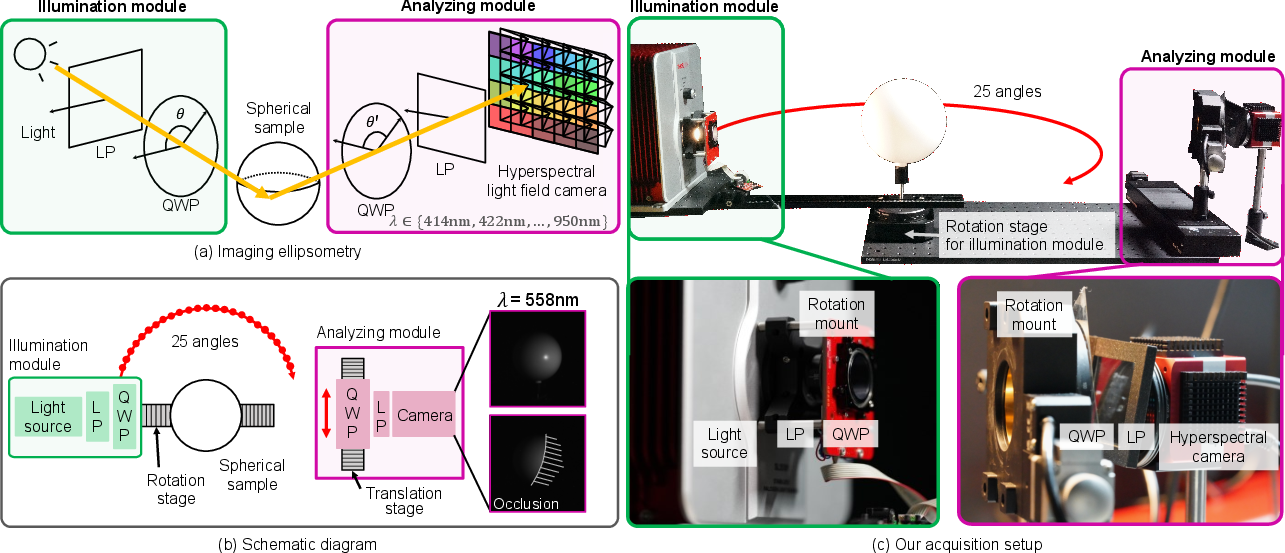
Figure 1: Schematic and photographs of the hpBRDF acquisition system, showing the illumination and analyzing modules, motorized rotation, and occlusion handling via QWP translation.
Spherical samples are used to exploit the continuous variation of surface normals, enabling dense angular sampling in a single image. The system captures images for all combinations of illumination/view angles, QWP rotations, and exposures, resulting in 3,744–12,480 images per material and acquisition times of 13–35 hours. Calibration procedures include geometric (multi-view camera and sphere fitting), radiometric (Spectralon reference), and polarimetric (polarimeter alignment) steps.
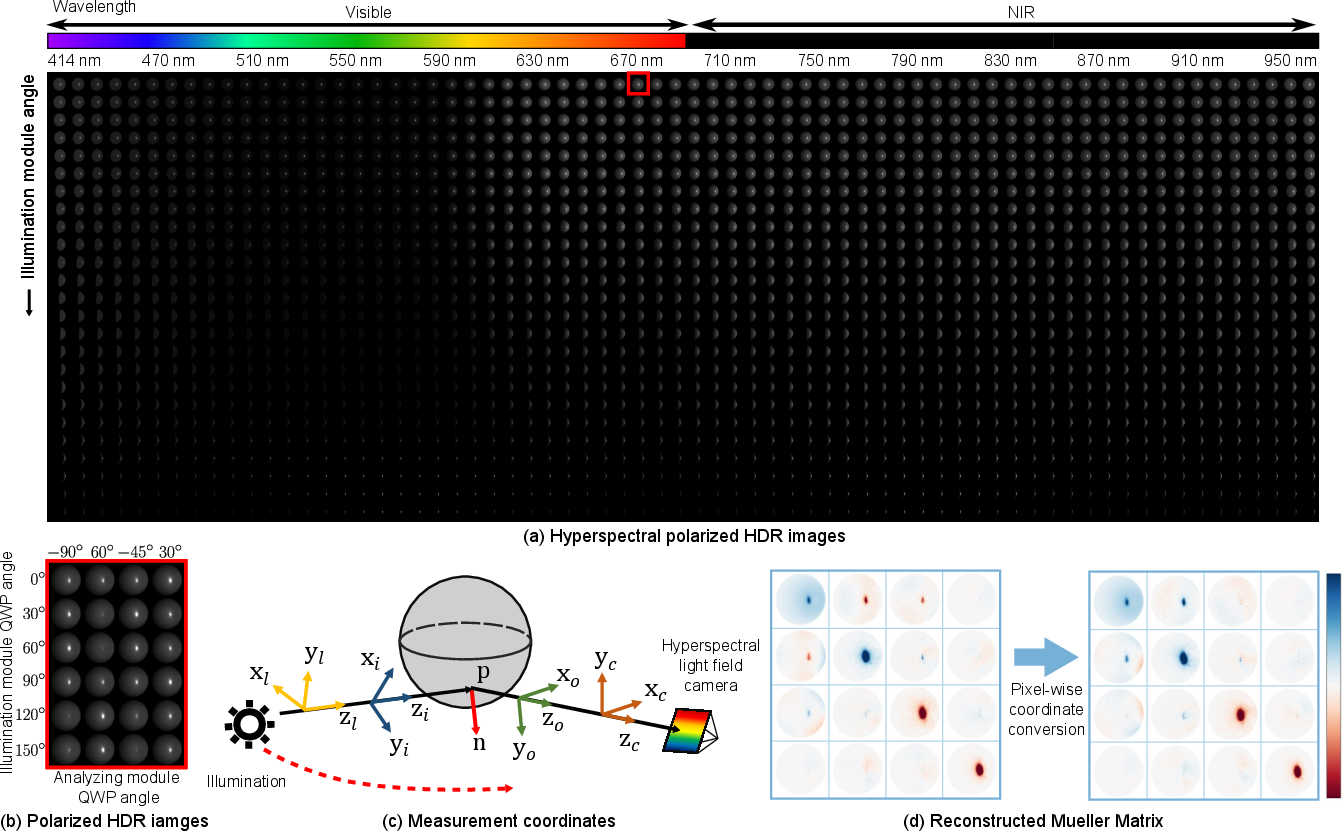
Figure 2: Example hyperspectral HDR images under varying illumination and QWP angles, and the coordinate systems for hpBRDF tabulation.
Dataset Construction and Representation
The hpBRDFs are reconstructed as 4×4 Mueller matrices for each angular and spectral bin, using least-squares fitting to the image formation model. The data is tabulated in Rusinkiewicz coordinates (ϕd,θd,θh) and 68 spectral bins, resulting in 13 GB per material. Missing entries due to occlusion or mechanical constraints are inpainted via 3D Gaussian convolution in the angular domain.
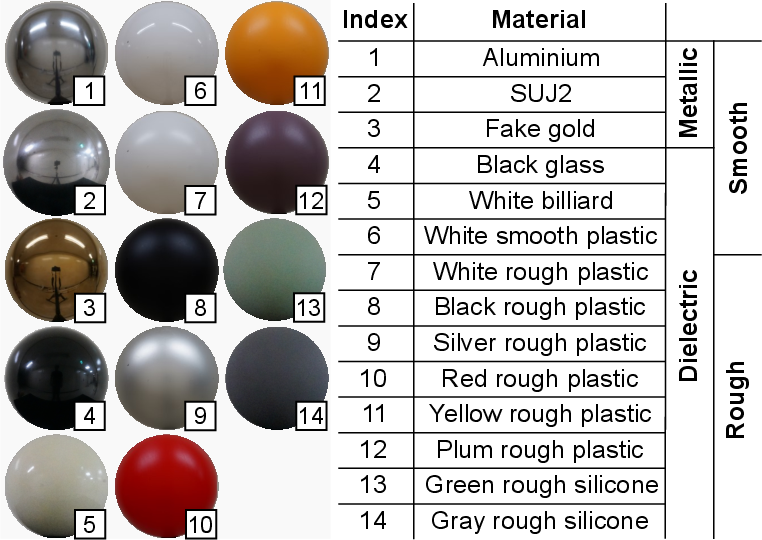
Figure 3: Photographs of the 14 real-world spherical samples included in the hpBRDF dataset.
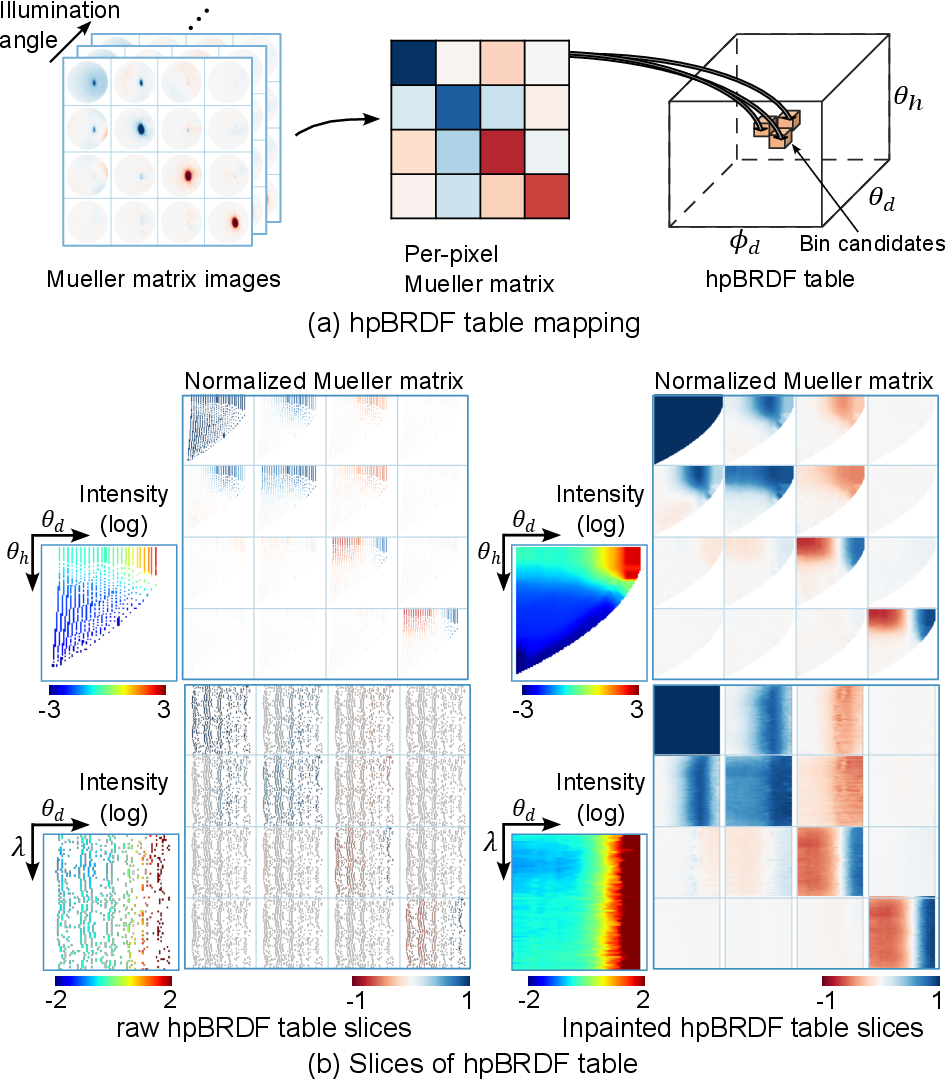
Figure 4: Construction of the hpBRDF table, showing mapping of per-pixel Mueller matrices and representative slices before and after inpainting.
Validation and Physical Consistency
Three validation experiments are performed: (1) comparison of reconstructed Mueller matrices with ground-truth elements (air, LP, QWP), (2) physical validity checks using Givens–Kostinski criteria, and (3) qualitative comparison with prior pBRDF datasets. 94.5% of reconstructed Mueller matrices satisfy physical admissibility across all bins. The hpBRDF tables show qualitative agreement with previous measurements, but offer denser and broader spectral coverage.


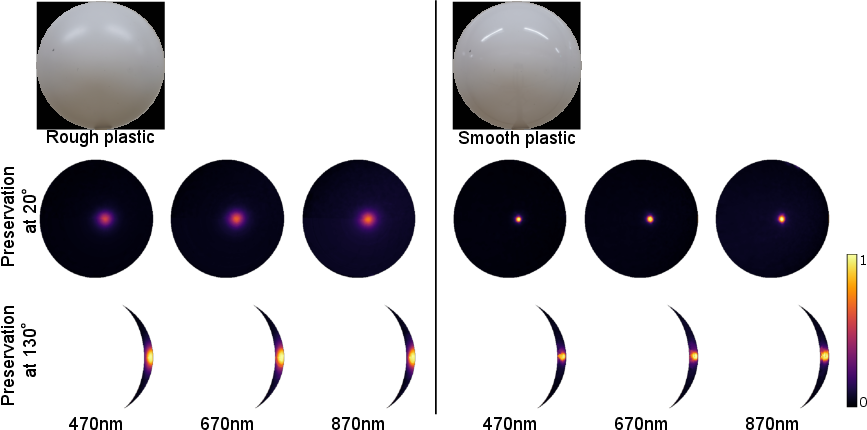
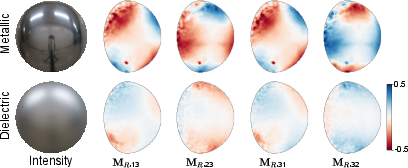
Figure 5: Validation of Mueller matrix reconstruction and comparison with existing pBRDF tables.
Rendering and Applications
The dataset enables physically accurate rendering of spectro-polarimetric images in arbitrary scenes using Mitsuba 3, supporting both intensity and polarization state simulation across visible-NIR bands. Example renderings demonstrate distinct polarization characteristics under RGB and NIR illumination, relevant for automotive, remote sensing, and scientific visualization applications.
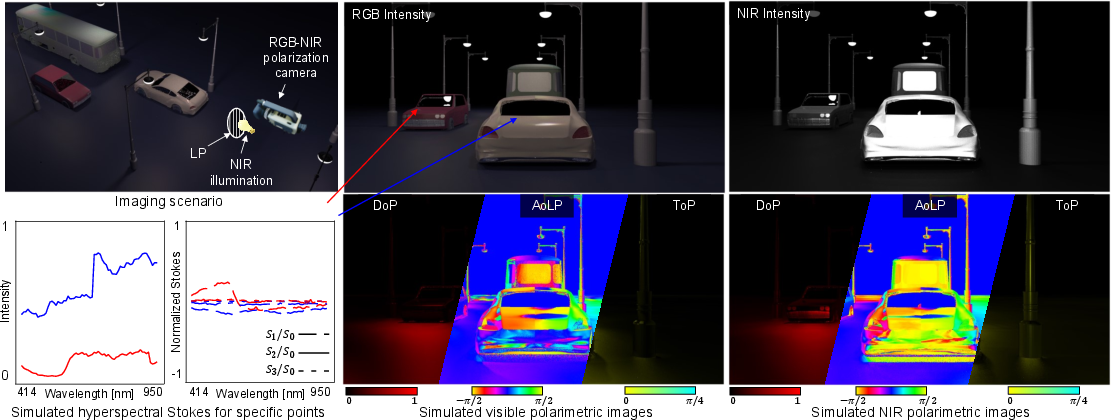
Figure 6: Hyperspectral polarimetric rendering of a nighttime driving scenario, illustrating differences in polarization between visible and NIR spectra.
hpBRDF Analysis: Wavelength, Material, and Geometry Dependencies
The hpBRDFs are analyzed using Lu-Chipman decomposition, extracting diattenuation, polarizance, polarization preservation, and retardance. Wavelength-dependent behavior is observed, with colored plastics exhibiting strong spectral intensity variation and preservation increasing at low reflectance wavelengths. Surface roughness analysis reveals that smooth materials maintain high polarization preservation in specular regions, while rough materials show rapid transitions and reduced preservation due to multiple scattering.

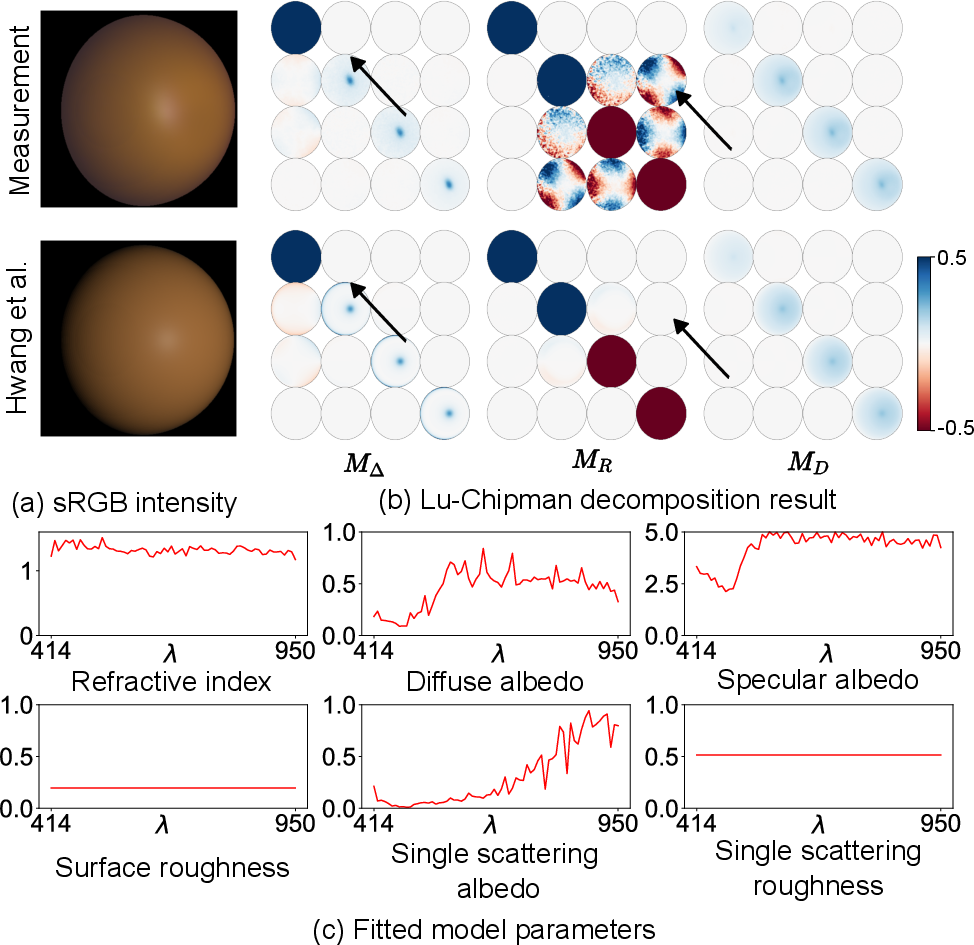
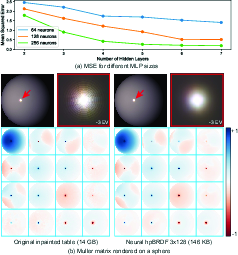
Figure 7: Visualization of diattenuation and polarization preservation for three colored rough plastics, highlighting wavelength-dependent characteristics.
(Figure 8)
Figure 8: Surface roughness effects on polarization preservation, showing sharp transitions for rough materials.
Metallic vs. dielectric materials are distinguished by sign inversions in non-diagonal elements of the retardance matrix, indicating distinct phase shift behaviors in reflection.
(Figure 9)
Figure 9: Retardance matrices for metallic and dielectric materials at 710 nm, showing opposite sign patterns in off-diagonal elements.
Compact Representations: Neural and PCA Models
To address the high storage and computational demands of tabulated hpBRDFs, the paper introduces implicit neural representations (MLPs) that map incident/outgoing directions and wavelength to the full Mueller matrix. These models achieve continuous interpolation, eliminate discretization artifacts, and reduce storage by five orders of magnitude (e.g., 146 kB vs. 13 GB) with minimal loss in fidelity.
(Figure 10)
Figure 10: Implicit neural hpBRDF representation, showing MSE across MLP configurations and visual comparison with the original table.
Principal component analysis (PCA) reveals low-rank structure in the hpBRDF data, with angular dimensions exhibiting stronger and more complex variation than spectral dimensions. The first two principal components capture characteristic patterns, supporting dimensionality reduction and efficient modeling.
(Figure 11)
Figure 11: PCA analysis of hpBRDFs, showing dimensionality and principal component patterns across angular and spectral slices.
Evaluation of Analytical Models
Analytical parametric pBRDF models fitted to the hpBRDF data reproduce sRGB intensity but fail to capture non-diagonal retardance components, particularly for metallicity indicators. Overestimation in depolarization and absence of key retardance features highlight the limitations of existing models for spectro-polarimetric rendering.
(Figure 12)
Figure 12: Comparison of analytical pBRDF model fitting to hpBRDF data, showing discrepancies in Lu-Chipman decomposition and fitted parameters.
Limitations and Future Directions
The acquisition system's spatial resolution is constrained by the hyperspectral camera's sensor division, limiting angular sampling density. The setup cannot capture anisotropic samples, and inpainting of missing Mueller matrices may not guarantee physical validity. Future work should explore physics-informed or data-driven inpainting, higher-resolution imaging, and extension to anisotropic and dynamic materials.
Conclusion
This work establishes a new standard for hpBRDF measurement and modeling, providing a dense, physically validated dataset and efficient acquisition methodology. The dataset enables accurate simulation and analysis of wavelength-dependent polarization phenomena, supporting advances in spectro-polarimetric imaging, rendering, and inverse material estimation. Compact neural and PCA representations facilitate scalable deployment in graphics and vision pipelines. Addressing current limitations will further enhance the utility and physical fidelity of hpBRDF models in scientific and engineering applications.











